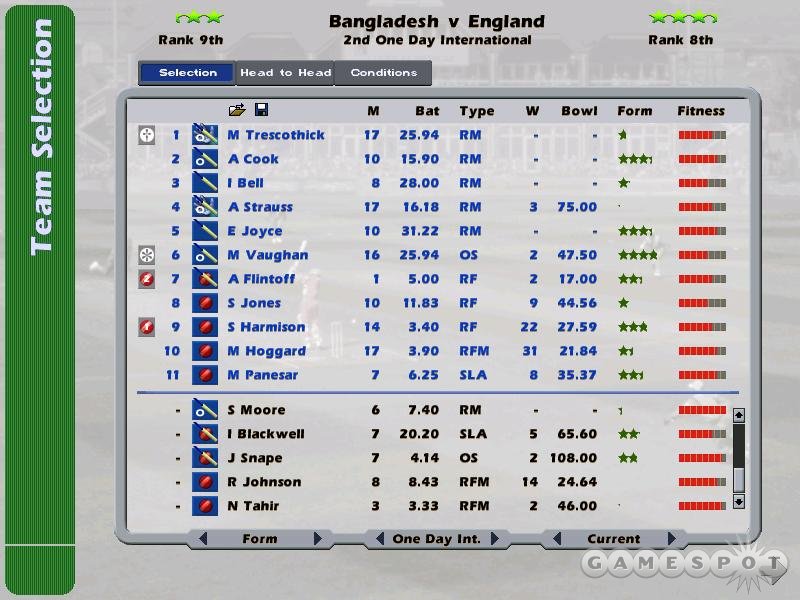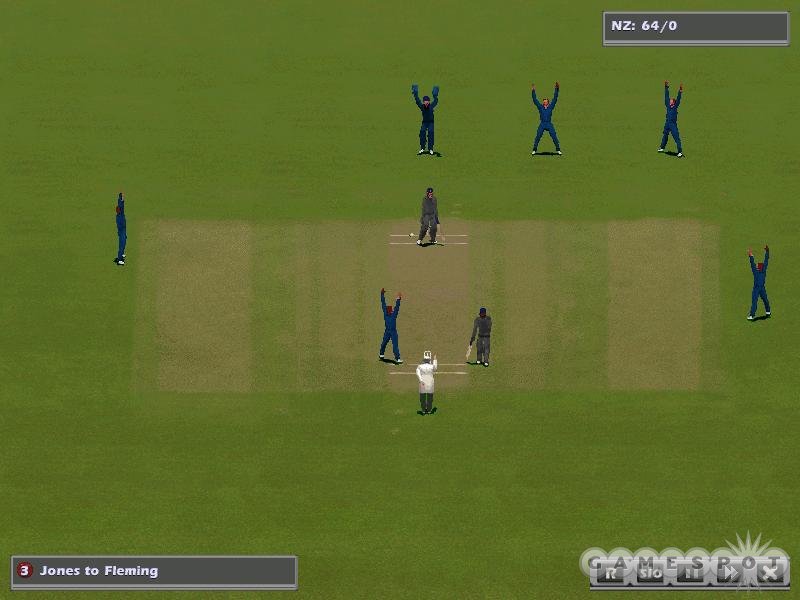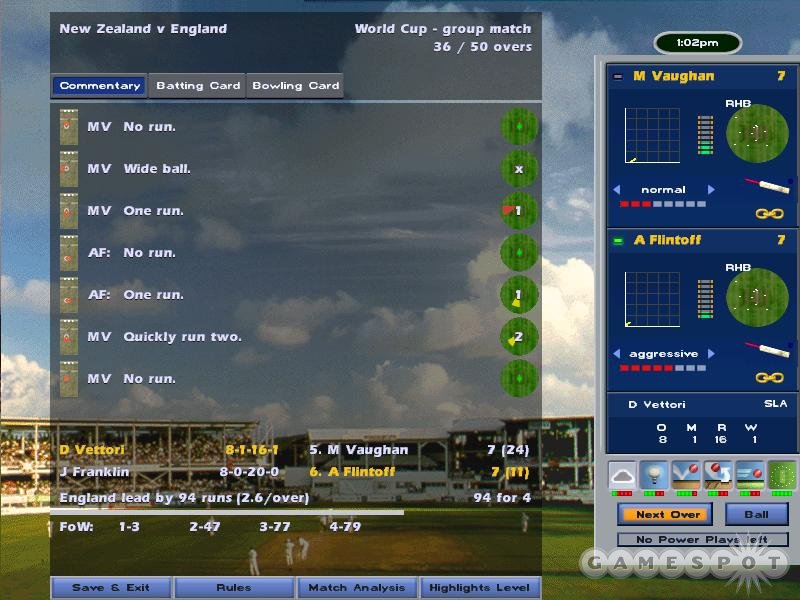Last year's nail-biting Ashes series, in which several crucial games came down to the wire, did wonders for cricket's public image. With Freddie Flintoff and friends now national heroes, the team behind the International Cricket Captain series has released this new version, which is updated for the 2006 season and endorsed by star batsman Kevin Pietersen. As before, ICC does a good job of re-creating the challenge of leading your favourite cricket team to glory, but the game remains disappointingly similar to previous versions.

In the full version of ICC 2006, you can captain any English county side and earn the right to lead England, or take on both roles straight away. Alternatively, you can avoid the county circuit and jump straight to the international arena with any of the 10 test-playing nations. The final option is to revisit cricket's past with four historic clashes involving England and either Pakistan or Sri Lanka--who are both touring England during summer 2006.
Once you've made your choice, you're soon put into the action. In the full game you get to bolster your squad with some new signings, but at the beginning you only get the choice of some pretty raw youth talent. In the international arena, however, you get to pick from every qualified player.
After assigning your players some coaching, you are quickly into the season with your opening fixture, and your first task is picking your team. You can base your decisions on current form, long-term performance, and the conditions. If it's a cloudy day, for example, then it makes sense to play a bowler who can swing the ball, while spinners should profit on a turning surface, especially towards the end of a four- or five-day game.
All batsmen have their own individual style of play, ranging from the very defensive to the very attacking. They may prefer to face spin or pace bowling or spin, or may favour hitting on the offside or legside of the wicket. Some are specialist openers, and it pays to bear this in mind when setting your batting order.
As the batting side, your influence is pretty limited. You get to dictate an aggression level for each batsman at the crease, then click 'next ball' or 'next over' to see the results. If this merely yields a boring succession of dot balls then you might choose to crank the level up, especially if you're chasing a target. If your players suffer a string of edged changes, or keep playing and missing, then you can calm things down. It's more likely, though, that reckless aggression will lead to the swift fall of a wicket. You get much more input when it's your turn to field, and a well-balanced attack should help you succeed in all conditions. The process is simple--select a bowler, decide which stump to aim at, where to pitch the ball, and whether to go over or round the wicket.

Because bowlers can suffer fatigue quickly, you need to juggle them around to keep creating chances and stop the opposition from capitalising on tired deliveries. You also need to keep thinking about your fielding positions. The game will automatically arrange the fielders depending where the bowler is aiming and how aggressive you want to be. This can then be tweaked, so if a batsman keeps hitting fours through the same part of the field you can put a fielder in the way.
Visually the game is disappointing, especially if you've played previous versions of ICC and hoped to see improvements. There are small differences in the way that the players move; for example, fast bowlers are slightly quicker, while spinners saunter in slowly. Players can be differentiated by hair and skin colour, but otherwise you may as well be looking at a low-budget cartoon. The audio is also rather basic, with just a few crowd noises, the clunk of leather on willow, and commentary from the BBC's Jonathan Agnew--many of whose remarks are unchanged from earlier versions of ICC.
You can argue that better graphics and audio wouldn't improve the most important aspect of the game, the management of your team. Without them, ICC2006 is little more than a database update on previous versions. But, at heart, this is still an engaging and challenging game that has the potential to keep cricket fans interested for weeks.
You certainly get plenty of matches in a season. At the county level, there are four competitions; the two-division championship, two one-day competitions, and the Twenty20 'thrashathon'. In the longer games, strategy comes to the fore as you attempt to emerge victorious over four days. In the one-dayers, you find a test of nerve as you push your batsmen's aggression up and cross your fingers. Twenty20 games are a riot--because there are so few overs that you throw all caution the wind when batting, and as the fielding side it's vital to save every run you can.
One handy feature is the ability to skip a game, which is useful if you've given up any chance of winning a particular competition. Your team won't perform at top ability without your leadership, but they still have a chance of winning, and it can save a lot of time. The players are also well created in style, if not in appearance. Leading bat swingers like Flintoff and Pietersen will thrive when instructed to chase runs, and it's good to see upcoming stars like Monty Panesar and Ed Joyce performing well. Squad training allows you to keep players in good form or develop the skills of younger cricketers, and when playing at home you can get the pitch prepared to suit batsman, seam bowlers, or spinners.
At the end of a county season, you're assigned your budget for next year. This is based on your performance in the various competitions, so if you're promoted or enjoy a good run in the cups, then you're rewarded with the chance to improve your squad. After haggling with existing players whose contracts have run out, you can spend your remaining income on buying new players. This includes a wide range of international players, which can be the best chance of introducing world-class talent to your team.
One interesting aspect of the game is that you don't get to see a player's raw attributes, as you can in many other sports games. Instead, you have to assess them based on their averages (over this season, last season, or over their whole career), and recent performances, an aspect designed to replicate the challenges faced by real-live cricket selectors.
Your total budget depends on how well you performed in the previous season, although larger counties automatically enjoy a larger income. As well as salaries, you can spend money on coaching, youth training, and physiotherapy. This means you can balance your resources between strengthening your team, improving your players, keeping them fit, and improving your chances of finding bright young talent. Once you've built up your team, you can play against other human players online, with a league system that uses a ladder-based points system, so you can challenge opponents of roughly similar ability.

As a cricketing-management game, ICC2006 occupies a unique niche. But when compared to other games, such as Football Manager 2006, it does appear light on micromanagement options. Stadium improvements, closer links with the youth team, or more complex training methods would all add more depth.
If you're into cricket and you've not experienced the ICC series before, then this could be the time to try it. But if you already own an earlier version, you might want to consider whether it's worth splashing out on an updated player database, the latest international fixture lists, some rule tweaks, and a picture of Kevin Pietersen.